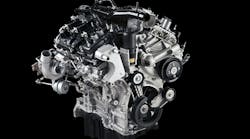SinterCast AB reported licensees of its compacted graphite iron production process produced 121,254 tons of CGI during 2016, or 2.2 million “engine equivalents,” which is equal to the record high output. The Stockholm-based technology developer further noted record results in its revenues for the same period, at SEK 17.2 million (est. $1.9 million.)
SinterCast is the world’s largest supplier of the control technology used by foundries to produce CGI — a lightweight alternative to gray iron and aluminum used mainly for automotive diesel engines and cylinder blocks, and some gasoline engine blocks. Other applications include industrial power engines parts, ranging from 2 kg to 9 metric tons.
In addition to licensing the technology, SinterCast supplies CGI producers with control system hardware and molten-metal sampling cups. Recently, it introduced a new RFID-based tracking technology for molten-metal ladles, known as LadleTracker.
SinterCast president and CEO Dr. Steve Dawson noted that the group achieved record results not only for revenue and series production during 2016, but also with its operating results and shipments of the proprietary “sampling cup.”
“During the fourth quarter, series production equaled the previous record high of 2.2 million engine equivalents (each ‘engine equivalent’ represents 50 kg of CGI) providing 5% growth compared to the fourth quarter of 2015, and marking two full years with series production at or above the 2.0 million engine equivalent threshold,” according to the group’s quarterly summary.
In detail, SinterCast offered that CGI output increased at most of its current series production programs, though it declined at some other: “The reductions were derived from one passenger vehicle program, one commercial vehicle program and an overall decline in industrial power production due to global reductions in energy, agriculture and mining activities,” according to the release.
On the other hand, the high series production boosted sampling cup shipments to a new record of 168,800, representing a 10% increase over the previous record set in 2015.
SinterCast offered a positive outlook for growth in series production, noting particularly the strong results for pick-up truck sales in the U.S. market, one of the leading sectors for diesel engines, which in turn represents one of highest-demand applications for CGI. Ford Motor Co. recently introduced a 3.0-liter V6 diesel for its 2018 F-150, the best-selling pick-up in the market.
Ford’s 3.0L V6 diesel engine will be based on a SinterCast-CGI cylinder block, and will be available starting in late 2017. This new engine joins a 2.7-liter V6 EcoBoost® gasoline engine, also built on a SinterCast CGI block, as two options available to buyers of the F-150.










